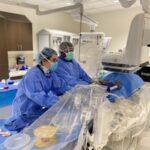Most of us know someone who suffers from chronic pain. Whether it be in the lower back, neck, joints, or elsewhere, pain that persists over months and years can be emotionally, as well as physically, debilitating. Thanks to specialists like Dr. Albert Zbik and Dr. Albert Ray of Pain Medicine Solutions in Miami, Florida, help is not far away.
But what is pain medicine? Beyond just the prescription of medications such as opioid analgesics that are intended to reduce the sensation of pain, pain medicine practitioners comprehensively evaluate patients and look for the physical, as well as psychological, reasons why patients experience chronic pain, otherwise known as maldynia. Dr Albert Zbik, a clinical psychologist and neuropsychologist, and co-director and owner of Pain Medicine Solutions, says the goal of pain medicine is to restore pain patients to a level of functionality that is consistent with their lifestyle prior to living with chronic pain. Treatments focus on enabling patients to perform their tasks of daily living more comfortably.
“The primary goal of Pain Medicine Solutions is the functional restoration of the patient. We want each patient to reach an optimal level of functional status, which may or may not mean his or her pain is cured completely.
“For instance, the goal for a stay at home mother with chronic pain would be for her to be able to do all of the things she used to do before the pain limited her, which may have required bending, twisting, lifting the children, and so on. We may have her work with a movement therapist to help her learn how to move without pain, with less pain, or without creating more pain. Restoring function is the primary goal; pain is a secondary issue,” says Dr. Zbik.
Dr Albert Zbik, a clinical psychologist and neuropsychologist, and co-director and owner of Pain Medicine Solutions, says the goal of pain medicine is to restore pain patients to a level of functionality that is consistent with their lifestyle prior to living with chronic pain. Treatments focus on enabling patients to perform their tasks of daily living more comfortably.
“The primary goal of Pain Medicine Solutions is the functional restoration of the patient. We want each patient to reach an optimal level of functional status, which may or may not mean his or her pain is cured completely.
“For instance, the goal for a stay at home mother with chronic pain would be for her to be able to do all of the things she used to do before the pain limited her, which may have required bending, twisting, lifting the children, and so on. We may have her work with a movement therapist to help her learn how to move without pain, with less pain, or without creating more pain. Restoring function is the primary goal; pain is a secondary issue,” says Dr. Zbik.  Pain medicine is a specialty recognized by the American Medical Association, and Dr. Albert Ray, psychiatrist and medical director of Pain Medicine Solutions, is board certified in pain medicine. “Pain medicine tackles pain from both the physical and psychological perspective. We treat people comprehensively, not just body parts,” he explains.
Drs. Zbik and Ray comprehensively evaluate each patient and then prescribe a pain program that blends western allopathic medicine with eastern medicine to achieve maximum results. Their approach is interdisciplinary, which means that the various modalities they prescribe for patients are all done under one roof, at least to the extent possible, and that each healthcare professional involved with a patient is kept up to date about the patients progress.
Dr. Zbik says, “The interdisciplinary approach is the standard of choice, and the 2003 world literature recommends it. At Pain Medicine Solutions, our interdisciplinary pain program has one captain who rallies a team of specialists to work toward the patients functional restoration. Unlike other approaches where the left hand doesnt know what the right is doing, our program entails us meeting once a week on each case so everyone is aware of the patients progress and we can adjust concurrent treatment. After each meeting, notes are transcribed and mailed to everyone involved with the case so that we maintain maximum control over the patients treatment and achieve the maximum benefit.”
Dr. Ray describes the types of pain they see most often. “Pain from spine, neck, lower back, hands, and shoulder injuries, amputations and phantom limb pain, headaches, arthritis, gastrointestinal, and many others, are common. We have a great in-house team to treat these issues, and we use a variety of treatments and techniques, including stretching, body movement, work with posture and balance, strengthening, reconditioning, yoga, trigger point injections, nutrition, activity level pacing, massage, meditation and relaxation training, plus the use of medications for anxiety, depression, sleeplessness, and, of course, pain.”
Some of their success stories are compelling. A woman with a brain aneurism suffered headaches for two and a half years everyday, averaging three trips to the emergency room per week for pain. After eleven sessions of an advanced technique called Eye Movement Desensitization and Reprocessing, or EMDR, she was headache-free. Seven years later, she is still living without headaches.
Dr. Ray tells the story of one patient who had severe osteoarthritis in his shoulders and knees, which led to a loss of movement and deformities. He was prescribed prolotherapy, which involves trigger point injections, among other treatments. After seven injection sessions, which lasted fourteen weeks, the patient was able to achieve a full range of motion with little discomfort.
The success stories continue. A baseball player with mid and lower back pain was restored to posses a full bat swing after his full treatment program, which included prolotherapy. A long shoreman with chronic pain was back on the docks after receiving a variety of treatments, including prolotherapy, EMDR, chiropractic therapy, and relaxation and cognitive therapies.
A woman who continued to have chest pain, post-heart attack, for three years, fully recovered with EMDR treatments. Dr. Zbik explains that in this womans case, the pain was not pathological in nature, but rather a body memory of the pain of the heart attack.
According to Dr. Zbik, body memory appears to be the culprit, at least in part, of chronic pain in many instances.
“Seeing a person enter our office in tears from pain, then seeing them leave with a smile on their face because their pain has been managed that makes my day,” says Dr. Zbik.
Dr. Zbik also suggests that “a good joke can be just as important as an injection.”
While they treat patients of all walks of life, ninety percent of their patient population consists of injured workers. Dr. Ray explains that workers compensation pays for the types of treatments pain medicine practitioners provide because it helps workers return to work sooner. “If the date of injury is less than 150 days, the release to work is actually 100 percent. Early intervention leads to better results.” Injured workers average 12-26 weeks in treatment, depending on their schedules, before they typically are released back to work.
Dr. Ray notes, “Most private insurance companies do not reimburse for this type of treatment, although this is changing. Medicare does reimburse, but on a limited basis. That is why most of our patients tend to be from the industrial sector.” Dr. Zbik adds, “We will negotiate fees to help whoever comes to the door.”
Drs. Zbik and Ray have been providing care to an underserved population of pain patients in South Florida for three decades. Their practice evolved from their work together on the interdisciplinary pain program at Baptist Hospital in the 1970s and 1980s. The doctors have three criteria for patients: 1) pain is the chief complaint, 2) the patient is not making the expected progress with current treatments, and 3) the patient is not a current surgical candidate or curative medical candidate.
Pain medicine is a specialty recognized by the American Medical Association, and Dr. Albert Ray, psychiatrist and medical director of Pain Medicine Solutions, is board certified in pain medicine. “Pain medicine tackles pain from both the physical and psychological perspective. We treat people comprehensively, not just body parts,” he explains.
Drs. Zbik and Ray comprehensively evaluate each patient and then prescribe a pain program that blends western allopathic medicine with eastern medicine to achieve maximum results. Their approach is interdisciplinary, which means that the various modalities they prescribe for patients are all done under one roof, at least to the extent possible, and that each healthcare professional involved with a patient is kept up to date about the patients progress.
Dr. Zbik says, “The interdisciplinary approach is the standard of choice, and the 2003 world literature recommends it. At Pain Medicine Solutions, our interdisciplinary pain program has one captain who rallies a team of specialists to work toward the patients functional restoration. Unlike other approaches where the left hand doesnt know what the right is doing, our program entails us meeting once a week on each case so everyone is aware of the patients progress and we can adjust concurrent treatment. After each meeting, notes are transcribed and mailed to everyone involved with the case so that we maintain maximum control over the patients treatment and achieve the maximum benefit.”
Dr. Ray describes the types of pain they see most often. “Pain from spine, neck, lower back, hands, and shoulder injuries, amputations and phantom limb pain, headaches, arthritis, gastrointestinal, and many others, are common. We have a great in-house team to treat these issues, and we use a variety of treatments and techniques, including stretching, body movement, work with posture and balance, strengthening, reconditioning, yoga, trigger point injections, nutrition, activity level pacing, massage, meditation and relaxation training, plus the use of medications for anxiety, depression, sleeplessness, and, of course, pain.”
Some of their success stories are compelling. A woman with a brain aneurism suffered headaches for two and a half years everyday, averaging three trips to the emergency room per week for pain. After eleven sessions of an advanced technique called Eye Movement Desensitization and Reprocessing, or EMDR, she was headache-free. Seven years later, she is still living without headaches.
Dr. Ray tells the story of one patient who had severe osteoarthritis in his shoulders and knees, which led to a loss of movement and deformities. He was prescribed prolotherapy, which involves trigger point injections, among other treatments. After seven injection sessions, which lasted fourteen weeks, the patient was able to achieve a full range of motion with little discomfort.
The success stories continue. A baseball player with mid and lower back pain was restored to posses a full bat swing after his full treatment program, which included prolotherapy. A long shoreman with chronic pain was back on the docks after receiving a variety of treatments, including prolotherapy, EMDR, chiropractic therapy, and relaxation and cognitive therapies.
A woman who continued to have chest pain, post-heart attack, for three years, fully recovered with EMDR treatments. Dr. Zbik explains that in this womans case, the pain was not pathological in nature, but rather a body memory of the pain of the heart attack.
According to Dr. Zbik, body memory appears to be the culprit, at least in part, of chronic pain in many instances.
“Seeing a person enter our office in tears from pain, then seeing them leave with a smile on their face because their pain has been managed that makes my day,” says Dr. Zbik.
Dr. Zbik also suggests that “a good joke can be just as important as an injection.”
While they treat patients of all walks of life, ninety percent of their patient population consists of injured workers. Dr. Ray explains that workers compensation pays for the types of treatments pain medicine practitioners provide because it helps workers return to work sooner. “If the date of injury is less than 150 days, the release to work is actually 100 percent. Early intervention leads to better results.” Injured workers average 12-26 weeks in treatment, depending on their schedules, before they typically are released back to work.
Dr. Ray notes, “Most private insurance companies do not reimburse for this type of treatment, although this is changing. Medicare does reimburse, but on a limited basis. That is why most of our patients tend to be from the industrial sector.” Dr. Zbik adds, “We will negotiate fees to help whoever comes to the door.”
Drs. Zbik and Ray have been providing care to an underserved population of pain patients in South Florida for three decades. Their practice evolved from their work together on the interdisciplinary pain program at Baptist Hospital in the 1970s and 1980s. The doctors have three criteria for patients: 1) pain is the chief complaint, 2) the patient is not making the expected progress with current treatments, and 3) the patient is not a current surgical candidate or curative medical candidate.


























